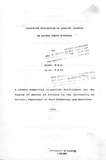| dc.description.abstract | Physical and chemical changes in sweet potato roots were studied with regard to seguential harvesting
time and various traditional and conventional storage conditions. Nutritional constitution and cooking characteristics were also considered in three selected cultivars. In addition, objective evaluation of changes in textural properties of stored roots and the degradation kinetics of vitamin constituents were investigated.
Increases in weight, specific gravity and dry matter content of the Cv. KSP 20 roots with chronological
age could be described by definite mathematical relationships using a computer program. Maximum dry matter accumulation in Cv. KSP 20 occurred in 160 days after planting and corresponded to the onset of foliage
senescence.
Roots of various weights were found to be significantly
different in physical and chemical composition.
Total solids, specific gravity, vitamin C and reducing sugar content all depended on the root weight. Total solids and root weight were found to be logarithmically related while specific gravity varied with root weight in an exponential fashion. Specific
gravity was also exponentially related to total solids.
All these relationships were described by suitable
equations.
The cultivar Nyeri had maximum total solids and specific gravity followed by Nyakura and lastly KSP 20. Nyeri also had twice as much crude protein as Cvs. Nyakura and KSP 20. All varieties were found to be good sources of Na, K and Mg. Vitamin C occurs in good quantities in all the three cultivars sufficient for all dietary groups except for children. These cultivars were however not good sources of provitamin A carotenoids.
Optimal cooking time depended on dry matter content of the roots. Hence, Cv. KSP 20 had least cooking time followed by Cv. Nyakura and lastly Nyeri. Cooking time could also be explained in terms of certain derived thermal properties of the roots. Optimal cooking times as gauged by sensory evaluation were also the times when there were no further decrease
in back-extrusion force. Back-extrusion was therefore a better method of objective measurement of textural properties of cooked potatoes than puncture test technique.
Roots buried in soil or saw-dust could be stored for 12 weeks, just as long as those stored at the
conventional temperature of 15*C, save for sprouting. Alterations in textural properties of Cv. KSP 20 roots under various storage conditions were objectively quantifiable by back-extrusion technique after 12 weeks storage duration. Least changes occurred in roots stored at ambient, in soil and in saw-dust and these changes could be explained in terms of corresponding
enzymatic modifications of root carbohydrate constituents especially starch. Development of physiological
disorders was responsible for the anomalous increases in textural indices for roots stored at 15*C and 20*C.
Degradation of vitamin C and 0-carotene in roots stored at various temperatures were found to obey first order reaction kinetics. In addition, it was deduced that the critical temperature of storage for Cv. KSP 20 lies in the neighbourhood of 15*C. | en_US |



